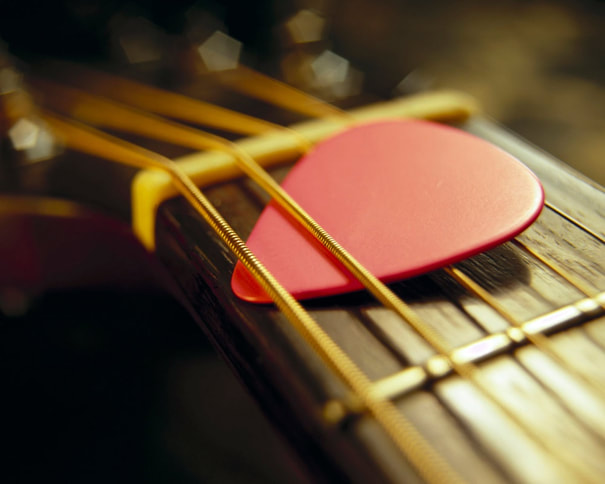|
Basic Guitar Lessons to help our beginner students to get started: How to Hold a Guitar Pick with Either Hand If you are right-handed, you will want to fret with your left hand and hold your pick in your right. Before you pick up your pick, take a moment to shake out and relax your right hand. Next, form a loose fist with your thumb on the outside of your index finger. Turn your hand so that your thumb is facing you. Slide your pick between your thumb and the middle of your index finger. Keep a relaxed grip on your pick with the pointed end sticking out away from your hand. Your pick should be held under the center of your thumb. You typically want to leave about a half inch of your pick sticking out from beneath your thumb. If you’ll be strumming your guitar, you might want to leave a slightly larger section of your pick exposed. If you need to pick for accuracy, allow a smaller tip of your pick to stick out. This lets you get closer to your strings. How to Strum Your Guitar Hold your picking hand over the sound hole on your acoustic guitar or over the body if you are playing electric. Don’t rest your hand on the guitar; instead allow your hand to hover. Now, use the pick to strum your guitar from the thickest string down. Don’t move your whole arm to strum your guitar. Instead, let the movement come from your wrist. Practice rotating your wrist like you are unscrewing a light bulb while keeping your wrist straight and your grip on your pick fairly loose and easy. When you strum, you should feel a rotation in your wrist, rather than bending. You can strum a chord from the top string down or the bottom string up. Try alternating down and up strums to hear the difference between each type of strum. You can try other rhythms or combinations like down-down-up-down to convey different feelings or evoke a genre. For example, punk music will typically use only quick down strums while an old country standard could be slow alternating up and down strokes. If you're interested in taking Guitar lessons on Zoom or In Person in Burbank, Glendale or North Hollywood, we have some of the best guitar lessons in Los Angeles. Our guitar instructors are picked by interviewing hundreds of guitar instructors and we have really high standards on both their teaching ability as well as their personality. If you'd like to talk to one of our instructors or set up a first lesson we have a guarantee that if you don't absolutely love your first lesson you don't have to pay for it. Please contact us at (818)902-1233 or on our website at https://www.losangelesmusicteachers.com/online-guitar-lessons-in-burbank-ca.html
|
Archives
July 2024
Categories
All
|
|
Music Lessons Available on All Instruments:
Piano Lessons
Guitar Lessons Voice Lessons Drum Lessons Violin Lessons Cello Lessons Saxophone Lessons Jazz Improvisation Lessons Flute Lessons Clarinet Lessons Singing Lessons Acoustic & Elec Bass Songwriting & Production |
Contact Us Now
|
Website by Never Alone Business Services


 RSS Feed
RSS Feed



